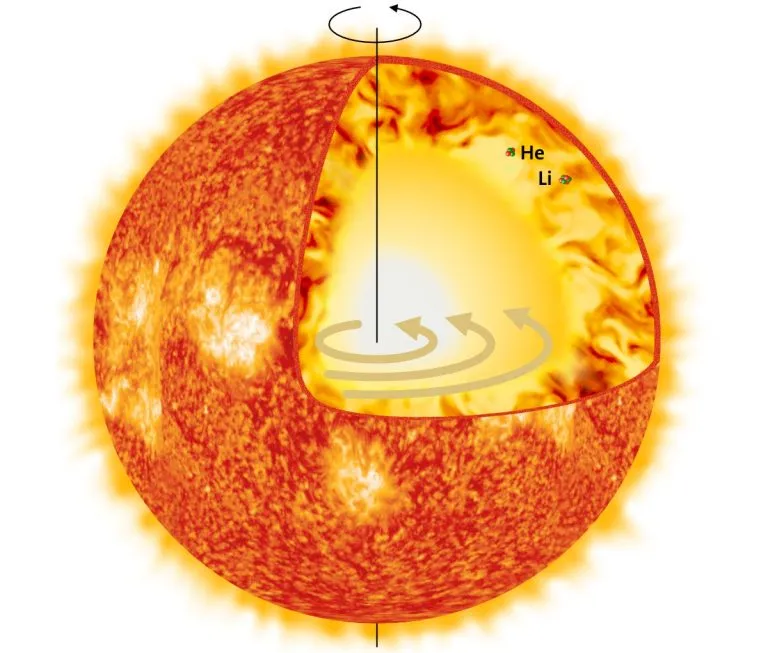An international team of astronomers has successfully developed a model to solve part of the "solar problem" A new set of data in the early 2000s reduced the chemical abundance of the solar surface, which contradicted the level predicted by the standard model used by astrophysicists. These new abundances are often questioned, but many new analyses have been carried out. Since they seem to be proved correct, they need to be adapted by the solar model, especially because they are the reference for the study of general stars.

A team of astronomers from the University of Geneva (unige), Switzerland, collaborated with the University of Liege, development A new theoretical model has been developed to solve some problems: considering the rotation of the sun (changing with time) and its magnetic field, they have been able to explain the chemical structure of the sun. The results of the study were published in the journal Nature astronomy.
"The sun is the star we can best describe, so it constitutes a basic test of our understanding of stellar physics." Patrick Eggenberger, a researcher in the unige Department of astronomy and the first author of the study, explained: "we have measurements of the abundance of its chemical elements and its internal structure, just like the measurement of the earth."
These observations should be consistent with those predicted by theoretical models designed to explain the evolution of the sun. How does the sun burn its hydrogen at its core? How is energy generated there and then delivered to the surface? How do chemical elements drift inside the sun under the influence of rotation and magnetic field?
"So far, the standard solar model we have used considers our stars in a very simplified way. On the one hand, it is about the transmission of chemical elements in the deepest layer, on the other hand, it is about rotation and internal magnetic field, which have been completely ignored so far," explained GA ë l buldgen, a researcher of the unige Department of astronomy and co-author of the study.
However, everything went well until the beginning of the 21st century, an international scientific team made a substantial revision of solar abundance through improved analysis. The new abundance has caused controversy in the field of solar modeling. Since then, no model has been able to reproduce the data obtained from helioseismology (analysis of solar vibrations), especially the abundance of helium in the solar envelope.

A new model and the key role of rotation and magnetic field
The new solar model developed by the unige team includes not only the evolution of rotation, which may have been faster in the past, but also the magnetic instability it produces. "We absolutely must consider the influence of rotation and magnetic field on the transmission of chemical elements in our stellar model at the same time. Since chemical elements that are crucial to life on earth are matured in the core of stars, they are important to the sun and general stellar physics, and have a direct impact on the chemical evolution of the universe," Patrick Eggenberger said.
The new model not only correctly predicted the concentration of helium in the outer layer of the sun, but also reflected the concentration of lithium, which until now still contradicts the model. "The new model correctly reproduces the abundance of helium, because the internal rotation of the sun imposed by the magnetic field produces turbulent mixing, which prevents this element from falling to the center of the star too quickly; at the same time, the abundance of lithium observed on the solar surface is also reproduced, because this same mixing transports it to the hot zone, where it is destroyed," Patrick Eggenberger explained.
The problem has not been completely solved
However, the new model does not solve all the challenges posed by helioseismology. "Thanks to solar seismology, we know which region 199500 kilometers below the surface of the sun has started the convective movement of matter. However, the theoretical model of the sun predicts a depth shift of 10000 kilometers!" S é Bastien salmon, a researcher at unige and co-author of the paper, explained. If this problem still exists in the new model, it opens a new door to understanding. "Thanks to the new model, we have clarified the physical processes that can help us resolve this key difference."
"We will have to modify the mass, radius and age of the solar stars we have studied so far," GA ë L buldgen said, detailing the next steps. Indeed, in most cases, solar physics has been transplanted into case studies close to the sun. Therefore, if the model for analyzing the sun is modified, this update must also be carried out for other stars similar to ours.
Patrick Eggenberger clearly pointed out: "this is particularly important if we want to better describe the host star of the planet, for example, in the framework of the Plato mission." The observatory composed of 24 telescopes should fly to Lagrange point L2 (1.5 million kilometers away from the earth, opposite the sun) in 2026 to discover and describe asteroids and improve the characteristics of their host stars.